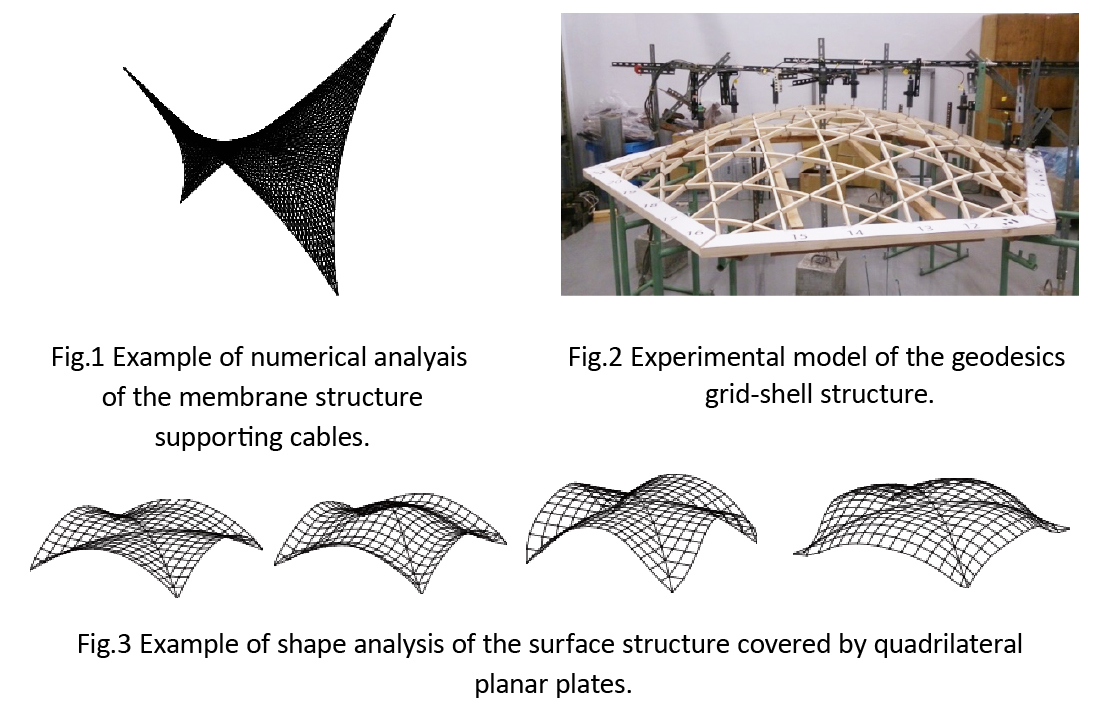Research Contents
Honma Group
Research items
The development of researches on the discretization of surfaces and curves in the computer graphics, however, application of geometry to control the curvature distribution of curves and surfaces to architecture and its spread is still under development. In particular, the discrete variational problem is essential for the architecture structure which determines the boundary shape. Therefore, it is possible to propose a new utilization and construction methods by the collaborations with Kajiwara Group and Mitani Group. Then we construct the methods to design the architecture structure superior in productivity and mechanical rationality which lead to the improvement of efficiency of the design and the production, together with the safety.
- Surface structure superior in productivity and mechanical rationality with good geometric properties.
- Discretization of geometric functionals and application to the finite element method.
- Application of folding along the curves in the origami engineering to the temporary structures.
Outline
- 1.Surface structure superior in productivity and mechanical rationality with good geometric properties
- 2.Discretization of geometric functionals and application to the finite element method.
- 3.Application of folding along the curves in the origami engineering to the temporary structures.
Structure forms with superior mechanical rationality such as the shell structure, the membrane structure and the tension structures convey the force efficiently mainly by the axial stress and resistance of the in-plane stress to support the structure. We construct a design method of curve and space structure with excellent mechanical rationality and geometric properties for the space structure constructed by such axial resistance. In addition, we investigate how to utilize the curves and surfaces with good geometric properties without practical applications to architectures so far.
In adapting free shape as the design of the surface structure, we need the surface structure with excellent productivity. Using the geodesics as the curved material enables the construction of the space curves from the straight materials. Also, using them for the surface covered with the flat quadrilaterals will make it possible to simplify the joints. In this way, we propose design methods of surface structure with excellent productivity and geometric properties. Based on those construction methods, together with the structural optimization problem, we eventually realize the structures superior in mechanical rationality and productivity with excellent geometric properties. As to the solutions, we consider the globally optimal solution(Pareto optimal solution) and locally optimal solution (local Pareto solution), or comparably reasonable solutions, including them.
There is a correspondence between the first fundamental form of the surface and the in-plate stress, and it represents the functional in the finite element method by using the elastic coefficients. The minima surface problem can be formulated as the minimization problem of the Dirichlet energy, which is equivalent to the shape determination problem of the iso-tension surface with constant initial stress in the finite element method. By applying above 1. to the shape determination problems, we realize the simple formulation independent of the coordinate systems and analysis.
We propose the temporary structures with superior portability and rigidity by the technique of the folding along the curves in the origami engineering. In disasters, it is necessary to supply a large number of temporary tents and houses promptly. Using the rigidity in terms of the surfaces formed by the folding along the curves, we present the shape analysis method of the structure suitable for the temporary tents and their applicability.

Placement in the project
1-1.The discrete developable surfaces are known to be useful for architectural structures. Also, we investigate the surfaces with excellent geometric properties in the viewpoint of mechanical superiority and list the useful discrete surfaces and establish the construction methods. In ref.2 and 10, we proposed the shape analysis method of the membrane structure, which we intend to develop further in this project.
1-2. We investigate the surfaces with excellent geometric properties from the viewpoint of productivity in a similar manner to 1-1. We proposed the shape determination method of geodesics grid-shell structure in ref.6, which we intend to develop further in this project.
1-3.We need the solution satisfying both 1-1 and 1-2, or the solutions close to them (excellent solution). In ref.7,8 and 9 we have shown the proposal of searching the excellent solutions and the achievement of utilizing those solutions, we clarify the optimality of the shape determined by the solution and the criteria of productivity.
2.The new discretization method obtained by the collaborations with Kajiwara Group can be applied to the finite element method which is highly versatile in engineering. In ref. 2 we proposed a method based on the discrete differential forms, which we will develop further in this project.
3.We list temporary structures that are regarded as important from the viewpoint of disaster prevention and security as an example of practical structures by the discrete developable surfaces, which is suitable for the groups collaborating for this project.
References
- 宇都宮尋史, 本間俊雄, 横須賀洋平:Lagrange 未定乗数法を用いたケーブル補強膜構造の形状・裁断図同時解析, 膜構造研究論文集, No.31 (2019) 掲載前
- 横須賀洋平, 本間俊雄:離散微分形式に基づくケーブル補強膜構造の初期形状解析, 日本建築学会構造系論文集,Vol.83, No.754, pp.1801-1809 (2018)
- 和田大典, 本間俊雄:構造形態創生法を活用した鉄骨 曲面形態の構造デザイン ―TOTOミュージアムの曲面形状決定と力学検討―, 日本建築学会技術報告集, No.56, pp.117-122 (2018)
- Y. Yokosuka, T. Honma:Form-finding Analysis for Reversed Hanging Membrane Forms with Constant Force Density, Asian Congress of Structural and Multidisciplinary Optimization (ACSMO), Paper-ID 0188 (2018)
- 西森裕人, 本間俊雄, 横須賀洋平:自由曲面グリッドシェル構造の部材長一様化と接合角を考慮した形態創生, 日本建築学会構造系論文集, Vol.81, No.721, pp.565-574 (2016)
- Y. Yokosuka, T. Honma:Geodesic Search on Triangle Mesh for Frame Structures, Proceedings of the International Association for Shell and Spatial Structures Annual Symposium (IASS), Paper-ID 1461 (2016)
- N .Tanaka, T. Honma, Y. Yokosuka:Structural Shape Optimization of Free-Form Surface Shell and Property of Solution Search Using Firefly Algorithm, Journal of Mechanical Science and Technology, Vol.29, No.4, pp.1449-1455 (2015)
- 永田洸大, 本間俊雄:優良解探索群知能による自由曲面シェル構造の多目的最適化, 日本建築学会構造系論文集, Vol.78, No.690, pp.1429-1437 (2013)
- 本間俊雄, 野瑞憲太:解の多様性を考慮した遺伝的アルゴリズムによる構造形態の創生, 日本建築学会構造系論文集, No.614, pp.35-43 (2007)
- 本間俊雄, 合田雄策, 安宅信行:座標値を未知量とした有限要素技術による張力構造解析の一方法, 日本建築学会構造系論文集, No.602, pp.161-169 (2006)


 Return to Top Page
Return to Top Page